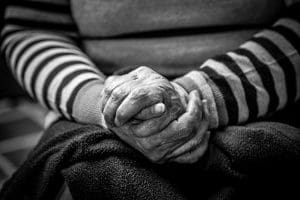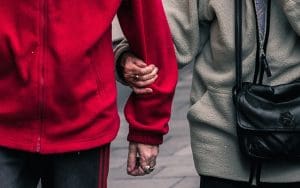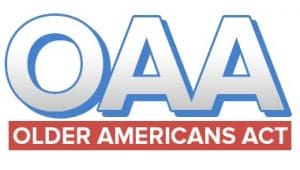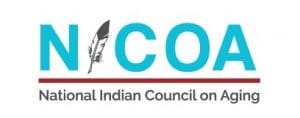The National Indian Council on Aging (NICOA) grew out of the First National Indian Conference on Aging in 1976. Its board of directors represented Indian tribes and tribal elders from across the country.
In 1978, NICOA successfully advocated for the passage of Title VI of the Older Americans Act (OAA). In 1981, NICOA conducted a national study to determine which age tribal communities consider to be “elderly”. The data resulted in enabling tribes to self-determine the age at which they considered “elderly”; whereas, in the non-Indian world the age was established at 60.
After 43 years, NICOA is still advocating on behalf of the nation’s tribal elders. It is recognized by other national aging organizations as the leading organization representing tribal elders and their needs. The following issues represent the State of Tribal Elders that NICOA is working to minimize, mitigate and ameliorate, but are a fraction of the overall needs.
The Issues:
- Population: According to the Administration for Community Living/Administration on Aging (ACL/AOA), the American Indian and Alaska Native population age 65 and older was 301,418 in 2019 and is projected to grow to more than 648,000 by 2060. In 2019, American Indian and Alaska Natives made up 0.6 percent of the elder population, and by 2060, are projected to make up 0.7 percent of the population.
The number of American Indian and Alaska Natives age 85 and older is projected to increase from 26,916 in 2019 to 118,905 in 2060.In 2019, half (51%) of all older American Indians and Alaska Natives lived in seven states: Oklahoma (36,095), Arizona (28,868), California (25,666), New Mexico (20,649), North Carolina (16,517), Texas (14,825), and Washington (11,523).
 Health: American Indian and Alaska Natives have higher mortality rates than other Americans for several conditions including chronic liver disease and cirrhosis (368 percent higher), diabetes mellitus (177 percent higher), unintentional injuries (138 percent higher), and chronic lower respiratory diseases (59 percent higher [Indian Health Services 2014]).
Health: American Indian and Alaska Natives have higher mortality rates than other Americans for several conditions including chronic liver disease and cirrhosis (368 percent higher), diabetes mellitus (177 percent higher), unintentional injuries (138 percent higher), and chronic lower respiratory diseases (59 percent higher [Indian Health Services 2014]).
The need for long-term services and supports, based on the health status of American Indians and Alaska Natives, can best be demonstrated by the following:
-
- Bathing: Twenty-two percent of American Indians age 65 and over require assistance as compared with 11 percent of the general population.
- Dressing: Fourteen percent of American Indians age 65 and over require assistance as compared with 5 percent of the general population.
- Eating: Ten percent of American Indians age 65 and over require assistance as compared to 3 percent of the general population.
- Getting In/Out of Bed: Fifteen percent of American Indians age 65 and over require assistance as compared with 6 percent of the general population.
- Walking: Thirty-two percent of American Indians age 65 and over require assistance as compared to 10 percent of the general population.
- Income Disparities: American Indian and Alaska Native elders experience significant income disparities from the general population (AARP Research Report 2015-08).
- Twice the percentage of older American Indians and Alaska Natives live below poverty as compared to the general population.
- Among American Indian and Alaska Natives ages 50 to 64, 54 percent are employed as compared to 66 percent of the general population. Forty percent of American Indian and Alaska Natives ages 50 to 64 are not in the labor force as compared to 30 percent of the general population.
- The mean total personal annual income for American Indian and Alaska Native elders age 50 and above is approximately $10,000 less than that of the same age of the general population, which equates to 25 percent lower income than the general population.
 Caregivers: In recent studies by AARP and the University of Washington, it is estimated that among the general population, one in five older adults are diagnosed with Alzheimer’s disease or dementia.
Caregivers: In recent studies by AARP and the University of Washington, it is estimated that among the general population, one in five older adults are diagnosed with Alzheimer’s disease or dementia.
Among the elder Indian population in southern California, research found that one in three elder Indians were diagnosed with Alzheimer’s disease or dementia. When extrapolated to the 300,000 Indian population, it is estimated that 100,000 (using the one in three finding) are diagnosed with this disease (or, using the one in five statistics, 60,000 Indian elderly diagnosed with this disease).
This population will require intensive and specialized care as the disease progresses. Currently, caregivers are family members who are untrained to provide this level of care. Additionally, this will undoubtedly put a strain on the caregiver, the family and the community mentally, physically and financially.
- Administration for Community Living/Administration on Aging (ACL/AOA): In the past two months, the Administration has reassigned ACL/AOA staff to its central office in Washington, D.C. This will have a major impact on the timely receipt of training and technical assistance needed by Older American Act Title VI grantees in Indian Country.
Federal agencies are required to consult with Indian tribes on any action that would have an impact on their programs and this requirement is an acknowledgment of the unique “government-to-government” relationship that tribes have with the federal government. No tribe was consulted about the realignment.
NICOA’s Recommendations for OAA Reauthorization
The issues, concerns and needs of the nation’s tribal elders are great and immense. As dire as they are today, they will increase exponentially over the next decade. NICOA intends to be at the forefront of these issues and provide recommendations for interventions.
As a result, NICOA believes that with the reauthorization of the Older Americans Act (OAA) this year, the Act needs to be amended to ensure that timely and appropriate services are available Indian communities and tribal elders. Our recommendations for amendments are as follows:
 OAA Recommended Amendments:
OAA Recommended Amendments:
- Increased Funding for Title VI: Funding should ensure that tribes receiving Title VI funds maintain funding levels that will guarantee services are delivered and at 1.5 times the inflation rate, as costs are higher on tribal lands. Requested Appropriation, Title VI, Subsection A: $42 million (increase of $10 million).
- Fully Fund Title VII (B): This title and subsection has never been funded, and with the increasing incidence of elderly abuse, fraud and neglect in Indian communities, this a need that must be addressed. Requested Appropriation: $10 million (increase of $10 million).
- Elevate the Director of The Office for American Indian, Alaskan Native and Native Hawaiian Programs to Assistant Secretary of American Indian and Alaskan Native Elders: This is a recommendation that has been submitted over the last 40 years during each reauthorization to no avail. The elevation of this office to Assistant Secretary is a recognition and importance of the unique government-to-government relationship between Indian tribes and the U.S. government.
- Move Title V (SCSEP) “Set Aside” Funds to Title VI: The “set asides” is an implicit acknowledgment of the unique government-to-government relationship enjoyed by tribes. It would consolidate elder programs for Indians in one office rather than fragmented among several federal agencies. Request: Total American Indian “set asides” by moving program from Department of Labor to Administration on Aging, amending OAA Title VI by adding a new Subsection D.
- Increase Funding for Caregiver Programs: It is estimated by some studies that one in five elders will suffer from Alzheimer’s disease or dementia. In 2018, there were over six million diagnosed with Alzheimer’s disease or dementia, requiring caregiver support equaling 18 billion hours. If one in five American Indian elders suffer from Alzheimer’s disease or dementia (assuming national rates are the same in Indian Country), that number today is 61,800. Requested Appropriation, Title VI, Subsection C: $20 million (increase of $10 million).
- Implement and Establish White House Conference on Indian Aging: A recommendation for over 40 years from tribal elders and tribal officials. It is a meeting that recognizes the federal trust responsibility and is equal to a national tribal consultation between Indian elders and the U.S. government.

I am a 63 year old native American , an enrolled allotees member of the Qinault Indian Nation in Grays Harbor County. When it comes to seeking help from my tribe, I feel very frustrated. They give little to no information as to what minute programs they offer up to the elders. I feel more as a victim then a member. They changed my enrollment # , papers they have say I was enrolled in I think 1979,I’ve been enrolled since I was born. My sisters # are the same and all in the 500 s now I’m in 1300 s When I turned 60 they have a program that entitled a member to receive an elders check once https://www.alliedcoverage.com/valliedhealth15/step1.html year . To date I have received one but did not receive it until I was 62.upon the pandemic, I previously receive paperwork to sell my fractional interests to the tribe. They sent papers saying they were ready to purchase portion of my property that is held in trust. I called the office to inform them I did not want to sell as I may need it at some time in the future or to give to my youngest son. I was told well that was ok because they didn’t need it anyway(,you see they have plans to move the town up to a higher area because of the land deterioration) .Now all members were expecting a check from the tribe due to the pandemic, around 3500.. per memberfor elders 2500 for others. I was sent a check, that I cashed for around 3200 I think. Within a week I received a letter stating they purchase my property! Later I also found the pandemic check on an old TANF card I still had. To me that was dishonest and down right wrong! I assumed I am protected by the federal gov. As promised in my treaty. I have no transportation and have not been able to get to the bottom of any of this . Also I should have had more property than what they stated as after they lost my grandmother’s will for 14 years then about 3 more years in probate, I did inherit other. Portions, that they have encumbrenced a leased in a. Petral motion since. They already have little to none in the Hellen Mitchell case that was won.My feseased grandmother was one of the original allotment owners .I believe I receive around $6000 is all. I m not even sure if they have taken my lot in taholah that I e had since my mother’s death back in the 60s .on paper now it shows like a shovel full of land is all.So if there is any advocate that is willing to point me in the right direction for help I would truly appreciate it. Thank you for your time.
.Cordially Enrolled member of theQIN